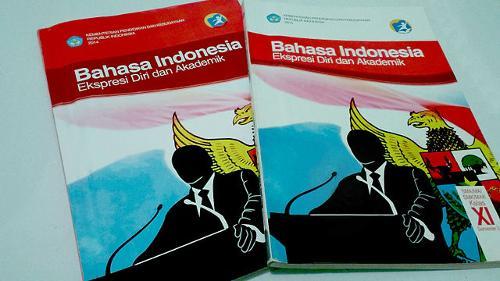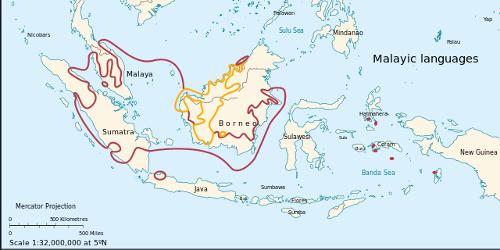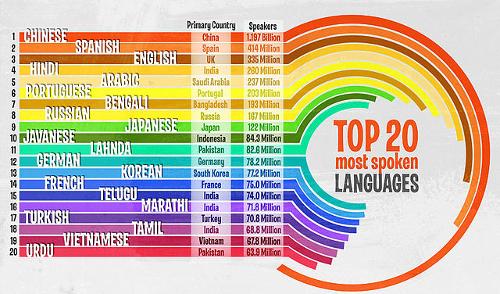INDONESIA
Language

Language
Cities in INDONESIA
| Jakarta | Yogyakarta |
Popular destinations INDONESIA
| Bali | Java | Sumatra |
Language
General
The official language in Indonesia is Bahasa Indonesia, commercial languages are English and to a decreasing extent Dutch. The many other languages of the archipelago fall into two main groups: the Malay-Polynesian language family and the "non-Austronesian" language family.
The Malay-Polynesian or Austronesian language family consists of about 250 languages, within which 40 main groups can be distinguished, such as Acehs, Malay, Buginese, Javanese and Sundanese.
Non-Austronesian languages include about 240 Papuan languages. More than a hundred of these Papuan languages have less than a thousand speakers. Textbooks Bahasa IndonesiaPhoto: Laura Pro CC4.0 International no changes made
Textbooks Bahasa IndonesiaPhoto: Laura Pro CC4.0 International no changes made
In present-day Bahasa Indonesia, the languages of the former rulers are still clearly identifiable. From the Portuguese words come mentega (butter), nona (miss) and sepatu (shoe). From Dutch are among others: mebel (furniture), bangrut (bankruptcy), karcis (cards), handuk (towel), pinter (clever) and donkrak (stupid power). Words like bodigar (bodyguard) and suplai (supply) are derived from English.
Bahasa Indonesia is a non-tonal language that is fairly easy to learn. The language is written in the Roman alphabet, words are pronounced as they are spelled, and the morphology is simple. Verbs and nouns are not conjugated.
The hardest part is using prefixes and suffixes to change base words into verbs and nouns. Accents are not indicated any more than in Dutch. The e at the end of the first syllable is always mute or toneless.
Like other languages, Indonesian has a predilection for abbreviations, which are often incomprehensible to outsiders (e.g. Pukesmas = Pusat Keséhatan Masyarakat).
From Malay to Bahasa Indonesia
The peoples of Sumatra and the Malay peninsula originally spoke different dialects of Malay. From these dialects a court language and a simple variant developed, which spread from Sumatra throughout the archipelago and served as a colloquial language mainly for the trade contacts between the various peoples. The need for a colloquial language was great because hundreds of languages were spoken in the archipelago. The fact that Malay had a simple structure was convenient. Malay, a trading language or "lingua franca" at the time, could easily be spread through the major trading centers on either side of the Straits of Melaka. Foreign groups such as Arabs, Chinese and Europeans also used this language.
Many Dutch migrants used an even simpler version of Malay when dealing with the indigenous population: Pasar Malay. Journalists and writers used Low Malay, a mixture of simple Pasar Malay and Classical Malay, incomprehensible to Javanese, the book language of the royal courts along the Sumatran coast. Writers, who wrote extensively in Low Malay, popularized Low Malay as a writing language. Malay languagePhoto: Kwamikagami at English Wikipedia CC 3.0 Unported no changes made
Malay languagePhoto: Kwamikagami at English Wikipedia CC 3.0 Unported no changes made
Malay spellings were very diverse until the 20th century, and there was no need to establish a standard. Europeans, on the other hand, had an interest in standardizing Malay, but were unable to answer the question of where the "best" Malay was spoken. The Protestant mission made a first attempt to provide a Bible translation in Classical Malay from the Riau Archipelago. Dutch and native officials used this Malay to communicate with each other, and it was therefore definitively elevated to Standard Malay. Important in this was the teacher C.H. van Ophuijsen, who wrote a "Malay grammar" and a "Malay textbook" at the beginning of the 20th century. As a result, the choice was made for a written language that was close to Classical Malay and that was very different from most other Malay dialects as well as from the popularized Low Malay.
Van Ophuijsen's Standard Malay gradually replaced Javanese Low Malay in the written language. In daily interactions, Malay-speaking Indonesians continued to use their own dialect, widening the gap between writing and colloquialisms.
On October 28, 1928, the participants in the Indonesian Youth Congress took the "Oath of the Young People", in which they promised, among other things, to fight for one language, Bahasa Indonesia. That Indonesian language was Van Ophuijsen's Standard Malay. Until the Second World War, however, Dutch remained an important competitor. Civil servants, for example, used Malay in contact with the population, but Dutch was taught in secondary schools. In 1942, the Japanese occupier banned the use of Dutch, which meant the definitive breakthrough of Indonesian as the national language. It became the language of education, civil service, politics, the press and literature. Javanese is one of the most widely spoken languages in the worldPhoto: Day Translations Team CC 3.0 Unported no changes made
Javanese is one of the most widely spoken languages in the worldPhoto: Day Translations Team CC 3.0 Unported no changes made
In order to obtain uniform grammar and uniform spelling, Indonesia worked together with Malaysia in a language union. In 1972 the two countries agreed on a new spelling, changing for example Djakarta to Jakarta and Aceh to Aceh.
At present, only a minority of the population speak the national language at home; it remains the language of the modern, especially urban elite. A large part of the population speaks no Indonesian at all and continues to communicate at home in the regional language or "Bahasa Daerah".
At the beginning of the eighties of the last century, Dutch was spoken by no more than one million Indonesians. Eighty percent of the population was born after 1950, so that Dutch is rapidly disappearing from Indonesia. The decline of Dutch is offset by the rise of English, a language that is also taught in secondary education.
The name Indonesia (Indonesia), first used by the British ethnologist G.R. Logan in 1850, is derived from the Latin. India and Greek nèsos (= island) means Indian archipelago.
Some words and expressions:
- Thank you = terima kasih
- Good morning = selamat pagi
- What is your name? = siapa nama saudara?
- Left = kiri
- Right = kanan
- Train = kereta api
- Plane = kapal terbang
- Shop = toko
- Tourist office = Kantor pariwisata
- No smoking = jangan mero cook
- Sunday = hari minggu
- Wednesday = hari rabu
- A = satu
- Two = dua
- Three = tiga
- Hundred = seratus
- Night = malam
- Hour = jam
- What time is it? = jam berapa sekarang?
- Signature = tanda tangan
Sources
Dalton, B. / De Indonesië reisgids
Elmar
Darmawie-van Oijen, J. / Indonesië : handboek voor reizigers
Babylon-De Geus
Homburg, E. / Indonesië
Elmar,
Indonesië
Cambium
Lyle, G. / Indonesia
Chelsea House
Martyr, D. / Indonesië
Van Reemst
Mastenbroek, B. / Kijk op Indonesië
Elsevier
Muller, K. / Indonesië : het 13.000 eilandenrijk
Becht
Oosterman, I. / Indonesië
ANWB Media
Schulte Nordholt, N. / Indonesië : mensen, politiek, economie, cultuur
Koninklijk Instituut voor de Tropen / NOVIB
Te gast in Indonesië
Informatie Verre Reizen
Wassing, R. S. / Indonesië : Java, Bali, Lombok, Sumbawa, Komodo, Flores, Sumba, Timor, Sumatra, Zuid- en Oost-Kalimantan, Sulawesi, Singapore
Gottmer
Witjes, B. / Indonesië
Stichting Teleac
CIA - World Factbook
BBC - Country Profiles
Copyright: Team The World of Info